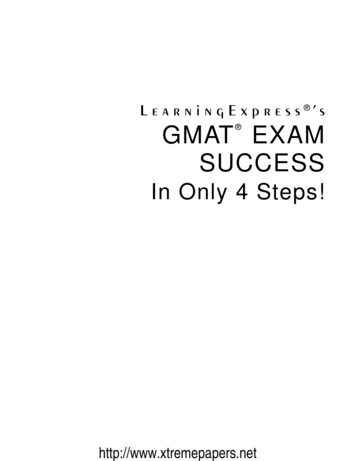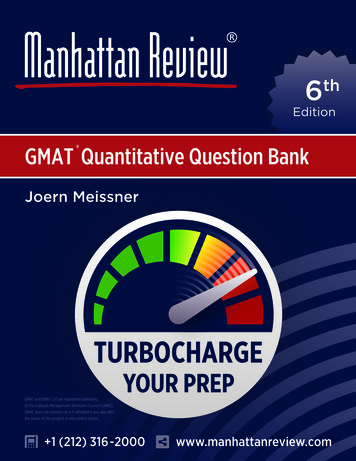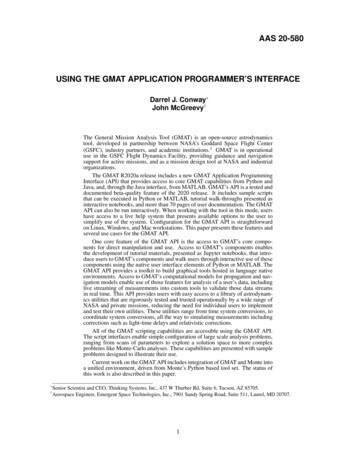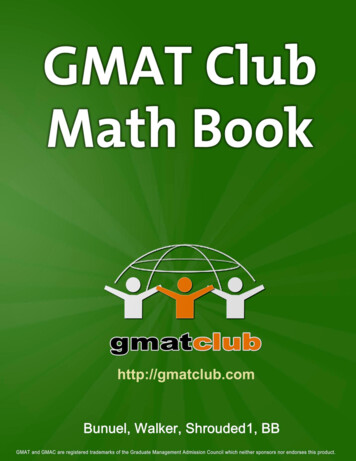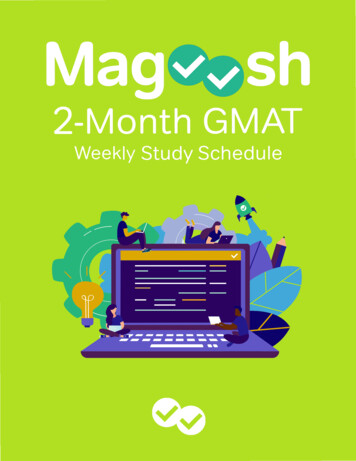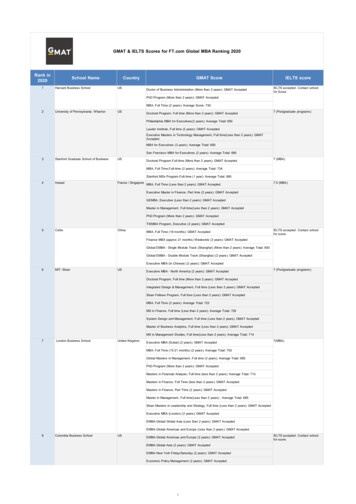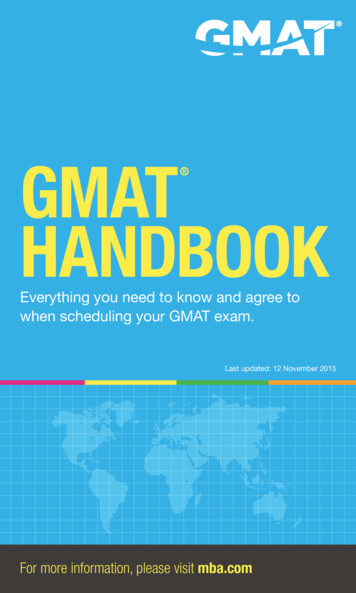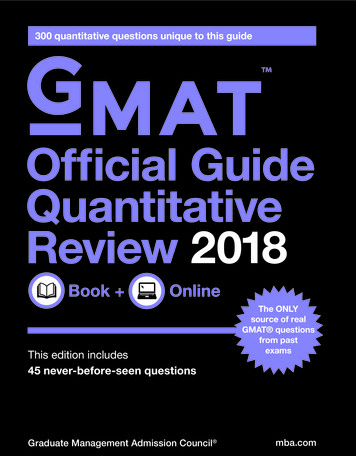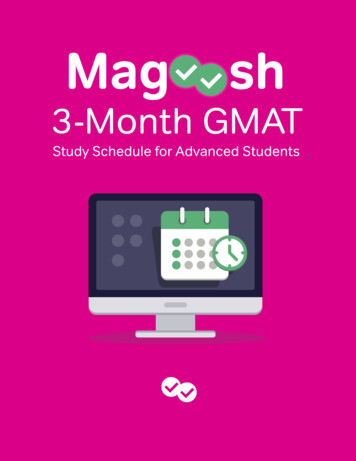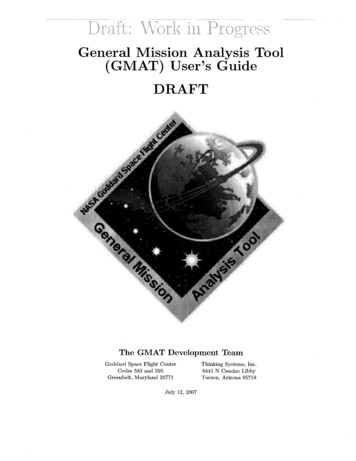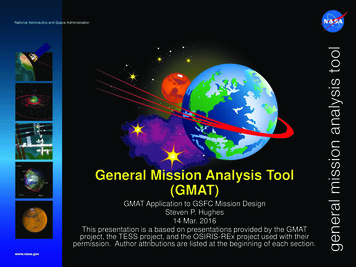
Transcription
General Mission Analysis Tool(GMAT)GMAT Application to GSFC Mission DesignSteven P. Hughes14 Mar. 2016This presentation is a based on presentations provided by the GMATproject, the TESS project, and the OSIRIS-REx project used with theirpermission. Author attributions are listed at the beginning of each section.
Outline GMAT Overview and Status Usage Basics GMAT Application to TESS GMAT Application to OSIRISICATT GMAT APPLICATIONS PRESENTATION2
GMAT Overview and StatusThis presentation was written by members of the GMAT team and isused with their permission.S. Hughes and T. Grubb,July 17, 2015
Mission Design and Nav. Applications Orbit design, optimization,and selection Control design Launch window analysis Sensitivity and Monte Carloanalysis Visualization Navigation data simulation Orbit product generation and Orbit determinationdelivery Event detection/prediction Fuel bookkeeping & lifetimeanalysis Propulsion system sizing Maneuver planning andcalibration Maneuver Support andreconstruction End-of-Life modelling Ephemeris predictionICATT GMAT APPLICATIONS PRESENTATION4
System ApplicationsCovariance AnalysisCoverage AnalysisGround SystemsUsed for: Tracking Schedule Sensor TaskingStation ContactPredictionsLaunch WindowAnalysisOBCLaunch VehicleUsed for: Memory Processing Speed Navigation ReqmtsUsed for: Vehicle Selection Target States Error AnalysisNavigation andMission DesignSolar Beta AngleComputationsShadow PredictionsRadiation BeltPredictionsBusUsed for: Radiation environmentmodeling Radiation hardeningDelta-V (Fuel) BudgetLifetime PredictionsSAM PEX Life time Study700C&DH Comm500Height (km)Used for: Onboard StorageSizing Station Selection toEnsure EnoughDownlink Time Navigation Reqmts600400" 2s ig fluxm ean flux300200Im pact on June 30, 20082987 days from epoch100Schatten 4/00 Predictions21 x 21 Geopotentialnom inal tim ing of s olar peakIm pact on March 8, 20103603 days from epoch005001000150020002500300035004000Days from Epoch of April 26, 2000 00:00:00 GMTPropulsionThermalUsed for: Radiator Sizing Solar Array AnglePowerUsed for: Solar Array Sizing Battery Sizing Ops PlanningICATT GMAT APPLICATIONS PRESENTATIONUsed for: Fuel Mass Tank Sizing Thruster Sizing Thruster Placement5 Operations
GMAT - More than the Sum of its PartsKey InnovationsExtensible platform forfuture fOptimizersKey BenefitsPhysics-BasedSystemModelsICATT GMAT APPLICATIONS PRESENTATIONRapid SolutionsNew/Better Solutions6
GMAT – Rocket Science for EveryoneThe ModelBenefitsMaximal Tech. TransferVisibility andTransparencyCost EffectiveICATT GMAT APPLICATIONS PRESENTATION7
ICATT GMAT APPLICATIONS PRESENTATION8
GMAT In ActionICATT GMAT APPLICATIONS PRESENTATION9
Project History 2001: Requirements gathering 2002: Architectural design 2003: Implementation of system core feature development 2010: Decision to prepare for operational use feature development 2012–2013: V&V effort Apr. 2013: First production release (R2013a) Aug. 2013: Operationally certified (R2013b)SSMO Status Presentation10
Recent Activities GMAT R2013a First production (non-beta) release Focused entirely on QA anddocumentation Very few new features—but manyimproved New support for ICRF coordinatesystems New aligned-constrainedcoordinate system New parameter types GMAT R2014a Public release of all R2013bfeatures New KARI-developed features State representations GMAT R2013b (internal) First operationally-certified release Focused on ACE missionrequirements Initial state file reader Binary-format ephemerisgenerator Attitude models Customizable orbit segment colors Mars-GRAM 2005 atmospheremodel LHS parameter dependencies New solver algorithms11
System Characteristics World-class quality software TRL 9, Class B, (Part of Center-wide CMMI Accreditation) Over 16,000 automated script and GUI tests Large system with extensible design 540k C LOC Core Script, GUI, and plugin interfaces 2 Interfaces to external systems (MATLAB and Python(under development) 890k LOC from other libraries (SNOPT (StanfordBusiness Software). SPICE (JPL NAIF), Wx-Widgets,VF13ad (Harwell), TSPlot Plotting Package (ThinkingSystems, Inc.), Mars-GRAM model (MSFC) Enterprise level support Large online support site (wiki, forums, issue tracker,downloads, etc) Extensive Documentation ( 850 page User Guide andReference Manual and 100 pages of step-by-steptutorials) Training (full-day live training courses and recordedtraining available via YouTube channel)ICATT GMAT APPLICATIONS PRESENTATION12
Extensibility GMAT’s modern architecture was designed forextensibility Extensible System Interfaces MATLABPythonAPI under developmentPlugins Multiple User Interfaces ScriptGUICommand lineAPI under development Extensible model subsystems Dynamics ModelsEnvironment ModelsEstimatorsMeasurementsPropagatorsODT EVALUATION MATERIAL13
Past and Present Usage
Usage: NASA Missions ARTEMIS – Enabling Innovation Objective: Studies acceleration, reconnection,turbulence and electrodynamics of the Moon’sInteraction with the Sun, Application: Resource-saving solutions haveenabled the mission to fly to this day, possiblyenabling synergistic science with MMS (March2015 Launch) Lunar Reconnaissance Orbiter (LRO): Objective: Mapping and lunar science, launched inJune 2009 Application: Saved the mission 10-15% fuel costLRO ManeuverOptimizationLCROSS TrajectoryDesign(equivalent to additional year of station-keeping) LCROSS Objective: Confirm the presence or absence ofwater ice in a permanently shadowed craternear a lunar polar region, June 2009. Application: Optimize an entire launch periodconsisting of dozens of trajectories rapidly and inan automated way, saving weeks of analyst timeand enabling larger-scale data analysis than wouldhave been otherwise practicalSOFTWARE OF THE YEAR AWARD PRESENTATION
Usage: NASA Missions OSIRIS-REx Objective: Return and analyze a sample of pristinecarbonaceous asteroid regolith Application: Used GMAT to optimize the entire 39-day launchperiod for OSIRIS-REx in a matter of minutes Multi-Scale (MMS) Objective: Investigate three-dimensional structure anddynamics of the elusively thin and fast-moving electron diffusionregion in key regions of re-connection. Application: Used GMAT for end-to-end formation modeling andoptimization for all phases of the mission, and now use it as thebaseline tool for ground system testing MAVEN Objective: Determine the role that loss of volatile compounds—such as carbon dioxide, nitrogen dioxide, and water—fromMars' atmosphere to space has played through time, givinginsight into the history of Mars' atmosphere and climate, liquidwater, and planetary habitability Application: Used GMAT for mars transfer optimization analysisand to study strategies for Mars orbit maintenance which hasunique mission constraints; passing through the atmosphere oneach and every orbitSOFTWARE OF THE YEAR AWARD PRESENTATION
Usage: NASA Missions Transiting Exoplanet Survey Satellite (TESS) Objective: Survey the brightest stars near theEarth for transiting exoplanets Application: Primary mission design andoperational maneuver planning tool. Foundcomplete and valid solutions for TESSrequirements in ONE week of analyst timecompared to MONTHS of effort with other toolsthat did not find trajectories that met allrequirements. Advanced Compositional Explorer (ACE) Objective: To measure and compare thecomposition of several samples of matter,including the solar corona, the solar wind,and other interplanetary particle populations,the local interstellar medium (ISM), andgalactic matter. Application: Used GMAT to rapidly investigatealternative station keeping strategies.SOFTWARE OF THE YEAR AWARD PRESENTATION
Usage Summary 8 NASA missions 5 Discovery proposal efforts 15 domestic and internationaluniversities 6 OGAs 12 contributing commercial firms 13 commercial firms using in openliterature 30 independent peer reviewedpublications citing analysisperformed using GMATGMAT is usedworld-wideICATT GMAT APPLICATIONS PRESENTATION18
Introduction to the GMATSoftwareThis presentation was written by members of the GMAT teamand is used with their permission.Jason Laing and Mojtaba AbedinOct 29, 2014NASA Goddard Space Flight Center
OutlineI.Key ConceptsIII. Tour of the ScriptLanguagea. Two Parallel Interfacesb.c.d.Resources andCommandsFields and ParametersExecution ModelII. Tour of the GraphicalUser Interfacea.b.c.d.e.GUI ControlsResources TreeMission TreeOutput TreeOrbitViewGeneral Mission Analysis Toola.b.c.d.e.f.g.Basic SyntaxControl StructuresUsing MathUsing ParametersSolversScript EditorBest PracticesIV. Data Files andConfigurationV. PluginsVI. Getting HelpNASA Goddard Space Flight Center2
KEYCONCEPTS
General Mission Analysis ToolNASA Goddard Space Flight Center4
KC1: Execution Model GMAT is like MATLAB:– You write a program (a “mission”), then run it togenerate output Not like Excel– Cannot generate output or manipulate resultswithout rerunningGeneral Mission Analysis ToolNASA Goddard Space Flight Center5
KC1: Execution Model Batch execution modelGMATScriptOutputGeneral Mission Analysis ToolNASA Goddard Space Flight Center6
KC2: Two Parallel InterfacesGUIScriptGUI and script are nearly interchangeable (but not totally).General Mission Analysis ToolNASA Goddard Space Flight Center7
KC3: Resources and CommandsResources Participants in a GMATmission Represent the “things” thatwill be manipulated Think of them as objects,with properties Most are “fixed” when themission startsGeneral Mission Analysis ToolCommands Events in a GMAT mission Represent the actionstaken on the resources Think of them as methodsor functionsNASA Goddard Space Flight Center8
KC4: Fields and ParametersFields Properties you can set ona resource Examples:– Spacecraft.Epoch– Thruster.DecrementMass– ReportFile.FilenameParameters Properties you cancalculate during themission Parameters often havedependencies Examples:– Spacecraft.Earth.Altitude– Spacecraft.EarthMJ2000Eq.BVectorAngle Sometimes a property is both a field and a parameter. Examples: Spacecraft.SMA, FuelTank.FuelMassGeneral Mission Analysis ToolNASA Goddard Space Flight Center9
TOUR OF THEGRAPHICALUSERINTERFACE
Resource Tree Contains all configuredresources in the mission Grouped into folders by olarSystemGeneral Mission Analysis ToolNASA Goddard Space Flight Center11
Mission Tree Contains the MissionSequence—sequence of allconfigured commands Special features:– Docking & undocking– Filtering controls– Command SummaryGeneral Mission Analysis ToolNASA Goddard Space Flight Center12
Output Tree Contains all output products Populated after missionexecutionGeneral Mission Analysis ToolNASA Goddard Space Flight Center13
OrbitView 3D graphics window Most complex of the graphical output types– Others include: XYPlot (2D plotting), GroundTrackPlot(2D mapping) Mouse controls:– Left button: rotation– Right button: zoom (horizontal motion)– Middle button: rotation normal to screen Configuration includes:– Camera controls– Resources to draw– Visual elementsGeneral Mission Analysis ToolNASA Goddard Space Flight Center14
Ex: Safety Ellipse ProximityOperations Objectives:Simulate proximityoperations Script:– Ex SafetyEllipse Highlighted features:– Coordinate Systems– GraphicsGeneral Mission Analysis ToolNASA Goddard Space Flight Center15
TOUR OF THESCRIPTLANGUAGEGeneralNASA GoddardMission AnalysisSpace FlightToolCenter16
Basic Syntax Syntax is based on MATLAB Single-line statements w/ optional linecontinuations Case sensitive Loosely typed Begin/End block statements Resources are created before used (exceptspecial defaults like SolarSystem)General Mission Analysis ToolNASA Goddard Space Flight Center17
Basic Syntax Script is divided into two sections:– Initialization (at the top)– Mission Sequence (at the bottom)– Divided by the BeginMissionSequence command Initialization - Resources Tree– Static assignment only Mission Sequence - Mission Tree– Manipulation of existing resources, cannot createnew onesGeneral Mission Analysis ToolNASA Goddard Space Flight Center18
Basic SyntaxCreate Spacecraft satsat.SMA 7000Create ReportFile rr.Filename 'MyReport.txt'BeginMissionSequenceReport 'Write SMA' r sat.SMAGeneral Mission Analysis ToolNASA Goddard Space Flight Center19
Using Math Math syntax is based on MATLAB Operators are matrix-awareBuilt-in FunctionsOperatorssincos elog10exp'transposeDegToRadRadToDeg powerabssqrtnormdetinvGeneral Mission Analysis ToolNASA Goddard Space Flight Center20
Using MathCreate Spacecraft SCSC.SMA 7100Create Variable period, mu, pimu 398600.4415BeginMissionSequencepi acos(-1)period 2 * pi * sqrt(SC.SMA 3/mu)General Mission Analysis ToolNASA Goddard Space Flight Center21
Using Parameters Parameters can have one of two types ofdependencies (or neither):– Central body– Coordinate system They are calculated on the fly when theyare used:– Spacecraft.MarsFixed.X– Spacecraft.Earth.BetaAngle If omitted, default dependency is usedGeneral Mission Analysis ToolNASA Goddard Space Flight Center22
Using ParametersCreate Spacecraft SCSC.CoordinateSystem MarsFixedCreate ReportFile rBeginMissionSequence% using parametersReport r SC.EarthMJ2000Eq.XReport r SC.Earth.BetaAngleGeneral Mission Analysis ToolNASA Goddard Space Flight Center23
Control Flow Three control flow statements:– If/Else – execute if a conditional is true– While – loop while a condition is true– For – loop a certain number of timesIf SC.Earth.Altitude 300% do a maneuverElse% continueEndIfGeneral Mission Analysis ToolNASA Goddard Space Flight Center24
Solvers Two types of solvers:– Target (using DifferentialCorrector)– Optimize (using either optimizer) Similar to loops, with specific nestedcommands:– Target: Vary, Achieve– Optimize: Vary, NonlinearConstraint,Minimize See the tutorials for examplesGeneral Mission Analysis ToolNASA Goddard Space Flight Center25
Best Practices1. Keep script minimal– Missing field settings will remain at default values2. Use the “Show Script” button on each GUIpanel3. Always explicitly state parameterdependencies– (Do as I say, not as I do—examples compressed.)4. Use ScriptEvent to encapsulate complexalgorithms5. Label your commands:Report 'Write SMA' r SC.SMAGeneral Mission Analysis ToolNASA Goddard Space Flight Center26
Getting Help For feature-specific information:– Help button on feature panel For scripting help:– “Show Script” button on feature panel Overall information:– GMAT User Guide (Help Contents)– Updated copy: http://gmat.sf.net/docs/nightlyGeneral Mission Analysis ToolNASA Goddard Space Flight Center27
Getting Help GMAT Wiki:– http://gmatcentral.org/ User Forum– http://forums.gmatcentral.org/ Mailing lists:– gmat-users@lists.sourceforge.net– gmat-developers@lists.sourceforge.net– Subscribe at http://sf.net/projects/gmatGeneral Mission Analysis ToolNASA Goddard Space Flight Center28
Application of GMAT to TESSMission Critical DesignThis presentation was written by members of the TESS FlightDynamics Team and is used with their permission.Author attributions are on the next slide.NASA Goddard Space Flight Center
Transiting Exoplanet Survey SatelliteOrbit & Mission DesignDon Dichmann, Navigation & Mission Design Branch, GSFCJoel Parker, Navigation & Mission Design Branch, GSFCChad Mendelsohn, Navigation & Mission Design Branch, GSFCLisa Policastri, Applied Defense Solutions (ADS)Ryan Lebois, Applied Defense Solutions (ADS)Craig Nickel, Applied Defense Solutions (ADS)Randy Persinger, Aerospace CorporationGreg Henning, Aerospace CorporationMarch 11, 2015
Agenda1. Logistics & Mission Overview2. Requirements3. Trajectory Design Process4. Solution Generation Process5. Finite Burn Modeling6. Launch Vehicle Dispersion Analysis7. Maneuver Planning8. Launch Window Analysis9. Statistical Delta-V & Contingency Analysis10. Results Summary11. Wrap-upTESS Mission Design Pre-CDR Peer Review, March 11, 201501-2
Mission Overview Science Objectives Spacecraft Diagrams Ascent PlanTESS Mission Design Pre-CDR Peer Review, March 11, 201501-3
TESS Science Goals and DriversTESS Mission Design Pre-CDR Peer Review, March 11, 201501 - 4
TESS 2-Year Sky Coverage MapAnti-Solar segmentsdrive /- 15 degCoverage of ecliptic poles drivesPitch angle (nominally 54 deg) Concentration of coverage at the ecliptic poles for JWST. Sacrifice of coverage in the ecliptic because Kepler-2 is already mapping thatregion.TESS Mission Design Pre-CDR Peer Review, March 11, 201501-5
Launch to Science Orbit TimelineBurn if necessaryDV BurnUPDATE IN BACKTCMPerigee PassagePhasing loops 2 & 3variable by launch datera 376,300 km (59 RE)LunarSwing-byA3A2ra 250,000 kmA1CalBurnTCMrp 108,400 km(17 RE)ap 200 kmInjectionPhasingLoop 1(5.5 d)P1P2PhasingLoop 2(approx.8 d)TCMP3PAMPeriod AdjustPhasingTransfer OrbitLoop 3(22 d)(approx.10.5 d)Ascent and Commissioning (60 days)(14 d)Science Orbit1TESS Mission Design Pre-CDR Peer Review, March 11, 2015Science Orbit2Science Operations01 - 6
Nominal Aug 10 solution: Inertial frame1 Oct 2019 00:00:00.000 UTCGTESS Mission Design Pre-CDR Peer Review, March 11, 201501-7
Nominal Aug 10 solution: Rotating framePhasingloop 3Phasingloop 2For a loop inthe1st quadrant,the Moon isbehind and lowersperigeeFor a loop in the4th quadrant, theMoon is aheadand raisesperigeePhasingloop 1TESS Mission Design Pre-CDR Peer Review, March 11, 201501-8
Flyby Plane ChangeRoughly 47 degree plane change at flybyTESS Mission Design Pre-CDR Peer Review, March 11, 201501-9
Transiting Exoplanet Survey Satellite02: RequirementsTESS Mission Design Pre-CDR Peer ReviewJoel ParkerMarch 11, 2015
Requirements ArchitectureLevel 1RequirementsDocumentLevel 1(Mission)Level nceRequirementsL3 IRDs / ICDsTechnicalAllocationsThisPresentationLaunch Vehicle IRD / ICDSpacecraft to Instrument ICDSpace to Ground ICDLevel 3(Element)Network Requirements / OICDFDF to MOC ICDMOC to SOC sDocumentTSORequirementsDocumentMission DesignRequirementsDocumentSOC to TSO ICDTESS to MAST ICDLevel 4(Subsystem /Sub-elementSpacecraft Subsystem Requirements SpecsInstrument RequSOC ReqMission DesignReqResponsibilityFDFNASA HQNASA GSFCOrbital SciencesMITLincoln LabNASA KSCNASA ARCLV ContractorC&DHEPSCSAPOCRF SThermalHPSTESS Mission Design Pre-CDR Peer Review, March 11, 201502-11
Launch to Science Orbit TimelineTESS Mission Design Pre-CDR Peer Review, March 11, 201501 - 12
Key L2 Mission Design RequirementsIDTitleRequirement SummaryMRD 2Mission Life2-year mission 2-month commissioningMRD 10Observation PeriodHASO duration 12.5 days per orbitMRD 54Launch PeriodLaunch opportunities on at least 5 days days per lunar cycleMRD 55Launch Window30-Second Launch windowMRD 42Ascent and Commissioning DurationAchieve mission orbit within 2 months after launchMRD 51Mission Orbit2:1 lunar-resonant orbitMRD 52Maximum Range in LAHOPerigee 22 ReMRD 101Mission Maximum RangeApogee 90 ReMRD 53Avoidance of Geosynchronous OrbitOrbit does not intersect GEO band for mission 100 years(TBD)MRD 56Eclipse Frequency and DurationNo eclipses longer than 5 hours and not to exceed 14 innumber (duration umbra 0.5*penumbraMRD 104Delta-V AllocationTotal ΔV 215 m/s (99% probability)MRD 129Longest Single ManeuverLongest continuous maneuver 95 m/sMRD 85Sun in Instrument BoresightFOV exclusion of 54 126 (TBR) for 15 minutes (TBR)MRD 64Missed ManeuverAchieve mission orbit w/ any single missed/abortedmaneuver. (Deleted)Change since PDR Peer ReviewConsistent with EXP-TESS-GSFC-RQMT-0001 Rev BTESS Mission Design Pre-CDR Peer Review, March 11, 201502-13
L3 Mission Design RequirementsIDParent IDL3 FD 1MRD 10,MRD 51TitleRequirementMission Orbit SMAComplianceThe target mission orbit Semi-Major Axis (SMA)shall be 38 Re.Comply.Designconstraint.LRPChange since PDRPeer ReviewConsistent with EXP-TESSGSFC-RQMT-0015 Rev (-)TESS Mission Design Pre-CDR Peer Review, March 11, 201502-14
L3 Mission Design RequirementsIDParent IDTitleRequirementComplianceL3 FD 3MRD 53Mission OrbitMinimum PerigeeFD shall target a mission orbit with a minimumperigee that shall stay above GEO radius 200km.Comply.Resultsshown to100 years.L3 FD 29MRD 52Mission OrbitMaximum PerigeeFD shall target a mission orbit with a maximumperigee that shall stay below 22 Re for theduration of the mission.Comply. All 20.5 ReL3 FD 30MRD 101Transfer OrbitMaximum ApogeeFD shall target a lunar flyby that results in atransfer orbit with a maximum apogee less than90 Re.Comply. All 80 ReWaiver pending on orbital debris requirementL3 FD {29, 30, 33}replace old L3 FD 3 interms of Kozai constant.LRPChange since PDRPeer ReviewConsistent with EXP-TESSGSFC-RQMT-0015 Rev (-)TESS Mission Design Pre-CDR Peer Review, March 11, 201502-15
L3 Mission Design RequirementsIDParent IDTitleRequirementComplianceL3 FD 21MRD 54Launch PeriodFD shall design for at least 5 launch days in anygiven Lunar cycle.Comply. At least 9sol’ns/mo forcurrent period.L3 FD 22MRD 55Launch WindowFD shall design for launch windows of at least 5minutes during each day of the launch period.Comply. Currentstrategy meets req.L3 FD 27MRD 42Commissioning DurationFD shall design the phasing loops and post lunarencounter transfer orbit to achieve mission orbitwithin 2 months after launch.Comply. PAM at 43 days.L3 FD 24MRD 85Sun in InstrumentBoresightFD shall design the PAM to occur when the sun isnot within a FOV of 54 126 centered on thecamera boresight axis (X-Z plane) for 15 minutes.Comply. Basis forsol’n selection.L3 FD 28MRD 104Delta-V BudgetFD shall design ascent-to-mission orbit to require nomore than 215 m/s delta-V with 99% probability ofsuccess.Comply. Seedetailed analysis.L3 FD 25MRD 129Maneuver MagnitudeThe largest maneuver magnitude shall be 95m/s.Comply. PAM 75m/sL3 FD 4MRD 56Eclipse Frequency andDurationFD shall target a mission sequence that limits thetotal number of eclipses from LV separation throughthe end of the prime mission to 2 eclipses with amaximum eclipse duration of 5 hours, and 14additional eclipses with a maximum eclipse durationof 4 hours.Comply. No morethan 11 4hr 1 6hrNeeds updatingRequirements added to flow from L2Change since PDR Peer ReviewConsistent with EXP-TESS-GSFC-RQMT-0015 Rev (-)TESS Mission Design Pre-CDR Peer Review, March 11, 201502-16
Delta-V BudgetConsistent with EXP-TESS-GSFC-SER-0001 Rev BTESS Mission Design Pre-CDR Peer Review, March 11, 201502-17
Transiting Exoplanet Survey Satellite03: Trajectory DesignProcessTESS Mission Design Pre-CDR Peer ReviewJoel ParkerMarch 11, 2015
OverviewThe TESS trajectory design process is based on three components: Theoretical basis Two-body patched-conic first guess Kozai constantTisserand conditionImplementation of theory to approximate final trajectoryHigh-fidelity targeting Transitions approximate first guess to realistic final solutionTESS Mission Design Pre-CDR Peer Review, March 11, 201503-19
Implementation Overview General Mission Analysis Tool (GMAT) used forimplementation of design GSFC’s in-house high-fidelity trajectory design softwareUses first guess to seed numerical getingTESS Mission Design Pre-CDR Peer Review, March 11, 2015End-to-EndSolution03-20
GMAT Design Approach Two targeting stagesStage 1: Design from TranslunarInjection (TLI) through flyby toScience Orbit Multiple-shooting processStarts with patched-conic first guessTLIPAMStage 2: Backwards design fromconverged mission orbit to launchvehicle separation (addingphasing loops) Single-shooting processStarts with converged outboundsolution 2-body phasing loopsguessTLITESS Mission Design Pre-CDR Peer Review, March 11, 2015PAM03-21
Outbound Sequence Overview Multiple-shooting approach w/ 5 segmentsTLI swingby2dCP1tTLIXTLIXTOI PP1 Xswingby- -PAM 4dCP2tswingbyXswingbyPP2Xswingby XPAM-CP3tPAMXPAMΔVPAMcontrol pointpatch point Start with patched-conic initial guess for each segmentGMAT targeting sequence used to find smooth solution fromsegmented initial guessTESS Mission Design Pre-CDR Peer Review, March 11, 201503-22
Implementation Overview General Mission Analysis Tool (GMAT) used forimplementation of design GSFC’s in-house high-fidelity trajectory design softwareUses first guess to seed numerical getingTESS Mission Design Pre-CDR Peer Review, March 11, 2015End-to-EndSolution03-23
Theoretical basis The TESS trajectory has two critical features: Transfer orbit (result of lunar flyby)2:1 lunar resonant mission orbitLRPTESS Mission Design Pre-CDR Peer Review, March 11, 201503-24
Tisserand Criterion The Tisserand criterion holds that a quantity 𝑇 is constant before and aftera flyby:1𝑇 𝑐𝑜𝑠 𝑖 𝑎 1 𝑒 22𝑎Here 𝒂 is semimajor axis (scaled by distance between the primary bodies),𝒆 is eccentricity and 𝒊 is inclination to the orbit plane of the primariesThe Tisserand criterion is used for TESS to design the lunar flyby. We choose the value of 𝑻 to obtain the desired orbit properties of thetransfer orbit after flyby to mission orbit. The transfer orbit shape is driven by a timing condition: the need for thespacecraft at Post Lunar Encounter Perigee (PLEP) to nearly line up withthe Moon. The spacecraft-Earth-Moon angle at perigee is called PLEPmisalignment or the Lunar Resonant Phase Angle. We then use the value of 𝑻 to infer the shape of the orbit before flybyTESS Mission Design Pre-CDR Peer Review, March 11, 201503-25
Kozai Mechanism The Kozai Mechanism describes the long-term evolution of ahighly eccentric, highly inclined orbit due to a third body(Moon).The Kozai model implies that: Orbit semimajor axis is conserved Kozai parameter 𝑲 𝒄𝒐𝒔 𝒊 𝟏 𝒆𝟐 is constant, where 𝒆 is eccentricity and 𝒊 isinclination to the Moon orbit planeKozai mechanism predicts Eccentricity and inclination oscillate in unison, with a period of about 8years for a TESS-like orbit. (Therefore, perigee radius and inclinationoscillate together.)AOP relative to the Moon librates around 90 deg or 270 deg, if the initialinclination is higher than critical inclination 39.2 degTESS Mission Design Pre-CDR Peer Review, March 11, 201503-26
Kozai Mechanism (cont’d) Kozai mechanism is relevant to TESS becauseWe want mission perigee radius to remain between 6.6 Re (GEO) and 22 Re We want mission ecliptic AOP to remain near 90 deg or 270 deg, so line ofapsides stays out of ecliptic plane, and so long eclipses cannot occur near apogee For TESS orbit, 𝑒 0.55 so 𝐾 0.65 implies 𝑖 39 degWe exploit the fact that the lunar plane and ecliptic plane are near thesame, only 5 deg apart.Perturbing forces (especially the Sun) imply that the Kozai mechanism doesnot work exactly in the full force model. Nevertheless, like CR3BP, the Kozaimechanism is a useful technique for orbit designMethods described by Aerospace Corp in CSR and flight dynamics paper “A High Earth, Lunar ResonantOrbit For Lower Cost Space Science Missions” by Gangestad, Henning, Persinger and Ricker (AAS 13810)TESS Mission Design Pre-CDR Peer Review, March 11, 201503-27
1st Guess 2- and 3-Body Approximations Start with approximate flyby epoch Mission orbit 2:1 lunar resonance SMA 38 Re (NOTE: the mission does notrequire exact resonance)Set PLEP 17 Re 𝑒 0.55Choose K 0.64 𝑖 39 w.r.t. Moon orbitTransfer orbit (post-flyby) Match mission orbit 𝑟𝑝 , orbit plane, line of apsides Choose Tisserand value 1.15 𝑟𝑎 1.3 flyby Moon radiusChoose inbound/outbound flyby TA at flybyArgument of latitude 0 (asc.) or 180 (desc.) argument of perigeeAscending/descending choice & inclination w.r.t. Moon orbit J2000inclination Fixes RAAN and AOP of pre- and post-flyby arcsFixes Moon distance at flybyPre-flyby: Ascending/descending choice & J2000 inc. at TLI inclination w.r.tMoon orbitTisserand value & Rp at TLI 𝑟𝑎 1.03 flyby Moon radiusChoose inbound/outbound flyby TA at flybyArgument of latitude 0 (asc.) or 180 (desc.) argument of perigeeTESS Mission Design Pre-CDR Peer Review, March 11, 201503-28
1st Guess 2- and 3-Body Approximations Flyby Phasing loops Pre- and post-flyby velocity directions bend angle orbit planeBend angle eccentricity𝑣 (at Moon’s Sphere of Influence) SMAGuess a total phasing loop durationJ2000 inclination 28.5 typicallyLV separation altitude 200 kmP1, P2, P3 altitude 600 kmSame orbit plane and line of apsides as pre-flyby orbitPre-flyby radius from Tisserand criterionA3 radius pre-flyby radiusPhasing loop duration guess A2 radiusApogee radii A1, A2, A3, A4 P1, P2, P3 maneuversConnection to launch site Separation AOP coast duration (AOP - 90 )RA at coast injection RA at KSCTLIPAMTESS Mission Design Pre-CDR Peer Review, March 11, 201503-29
Lunar Flyby Orbit Geometry Options Data showsgenerally bestresults for: Pre-flyby lybyascending/descending canbe selectedFor operationalsimplicity, wecurrently useascending caseonly.Implies shortcoast solution atEarth departureFrom Gangestad, J. et al. “A High
(GMAT) GMAT Application to GSFC Mission Design Steven P. Hughes 14 Mar. 2016 This presentation is a based on presentations provided by the GMAT project, the TESS project, and the OSIRIS-REx project used with their permission. Author
